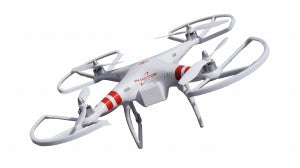Let’s start out with saying I was not a flight guy. To give you an idea of my experience in flight up to this purchase I had owned two flight style RC setups. The first being the Axe CP100 and the second was the Heli-Max 1SQ quadcopter. Both pretty small but I thought that learning on smaller less expensive systems first would be more cost effective. First flight on the CP100 I hit a bird cage and had to replace motors, tail assembly, blades, and body. Needless to say I did not get much more time on that before I decided to step it back a bit. The 1SQ was definitely a lot better for me. It was a lot more stable and easier to maneuver. Inside I could control it easily and I had a general sense of how it worked. Going outside you definitely had to be more careful as you were constantly fighting the wind to keep it stable. After several flights I understood the concepts but I still didn’t feel confident in flight. For the most part I went back to my cars allowing these little beasts to collect dust.
I was told on forums and by fellow RC pilots that going bigger would actually be easier. It made sense as something heavier would be less affected by wind. After doing a bit of research and seeing the benefit of being able to capture some amazing airborne footage I decided to pick up the DJI Phantom.
My maiden flight was without any video recording equipment what so ever. But let me tell you it was amazing. Without much control of the transmitter at all this thing was able to get off the ground, remain stable, and make me look like I knew what I was doing! After playing with all of the sticks to get a sense of how it worked I sent the Phantom up into the sky. So high I could barely see it. I then slowly brought the DJI Phantom back to earth. Coming down only a few small adjustments were necessary to bring the Phantom back down in the exact same location it took off from. Hovering ten feet in the air I was able to set the remote down and it would sustain its position in relation to earth. It was just so easy. Using the stock pack I did not get the flight time I would have preferred but that is to be expected with most stock setups.
I made it a priority to make a trip to the electronics store and I picked up the Go Pro Hero 3 Black edition. I then had it mounted in place and took some preliminary footage. I also grabbed two 2800Mah MaxAmps Phantom Packs for some extended flight time. Totally worth it! The average flight with equipment for me was just over 6 minutes. With the larger capacity pack I was seeing over 9 minute flights.
After a few different flights I felt confident and I was able to capture some good footage but it was a challenge to guess whether I got that desired shot or not. One unfortunate problem I was already aware of was that I could not have the Go Pro WiFi enabled as it would interfere with the Phantom. I basically had to run to my computer after I landed to see if I got the shot I was looking for. This was definitely not the most efficient method so back to the store I went for the last upgrade I have purchased up to this point. I picked up the Fat Shark Predator V2 FPV kit. With this I was able to mount a second camera on the Phantom and I could see the footage as I captured it. This setup really opened up the capabilities of where I could go and what I could see.
I could travel long distances without having the quad in sight. The DJI Phantom was also easier to maintain proper direction because I was always in the front seat. Be aware that this is not an effective method to monitor depth perception. Flying in open areas would be preferred. If you are in a tight area I would recommend a spotter to make sure you don’t hit anything.
I may look at more upgrades moving forward to increase flight time and stability but I feel confident now in navigating my quad over trees, water, and anything else that gets in my way. If you have any questions about my setup, our 2800mah packs, or a recommendation on a future upgrade please leave a comment below.
– Joshua Barker PR Manager

